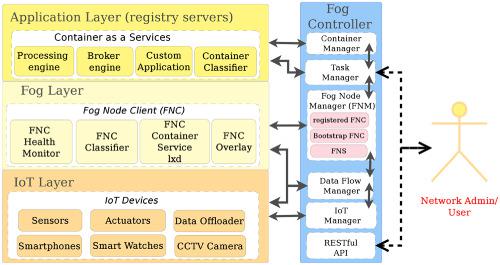当前位置:
X-MOL 学术
›
Int. J. Netw. Manag.
›
论文详情
Our official English website, www.x-mol.net, welcomes your
feedback! (Note: you will need to create a separate account there.)
Wireless‐Fog Mesh: A framework for in‐network computing of microservices in semipermanent smart environments
International Journal of Network Management ( IF 1.5 ) Pub Date : 2020-07-20 , DOI: 10.1002/nem.2125 Shabir Ali 1 , Mayank Pandey 1 , Neeraj Tyagi 1
International Journal of Network Management ( IF 1.5 ) Pub Date : 2020-07-20 , DOI: 10.1002/nem.2125 Shabir Ali 1 , Mayank Pandey 1 , Neeraj Tyagi 1
Affiliation

|
Large gathering events such as open air rock concerts and religious gatherings require a semipermanent communication and computation infrastructure for providing IoT‐based smart solutions. In these places, the installation of wired network is not a cost‐effective solution to provide connectivity. Wireless mesh network (WMN) presents itself as a quickly deployable and dismantable solution to provide wireless connectivity to IoT devices. In this paper, we have proposed a “wireless‐fog mesh” computing framework for installation of microservices in network devices of WMN. This requires continuous monitoring of residual resources of devices and associated network characteristics. Our proposed fog controller exploits underutilized resources of mesh devices and network metrics for mapping a microservice to a fog node. This controller uses a DHT‐based overlay of fog nodes (also acting as distributed MQTT broker) for disseminating resource profiles of fog nodes. The network metrics like path cost, routing loads, number of stations, and delay are used to implement a policy‐based FNS algorithm for electing a fog node to run microservice. We have designed and implemented a testbed that consists of 10 OpenWrt‐based Raspberry Pi3 node to form a WMN. We have deployed various microservices such as MQTT broker, air quality, web servers, annd video surveillance in fog nodes (mesh routers and access points) to test the FNS algorithm. The results establish that the FNS algorithm significantly outperforms the random node selection (RNS) algorithm and advocates the applicability of our wireless‐fog mesh framework for semipermanent use cases.
中文翻译:

无线雾网:半永久性智能环境中微服务的网络内计算框架
大型露天音乐会,宗教聚会等大型聚会活动需要半永久性的通信和计算基础架构,以提供基于IoT的智能解决方案。在这些地方,安装有线网络并不是提供连接的经济有效的解决方案。无线网状网络(WMN)本身就是一种可快速部署和拆除的解决方案,可提供与IoT设备的无线连接。在本文中,我们提出了一种“无线雾网状”计算框架,用于在WMN的网络设备中安装微服务。这需要连续监视设备的剩余资源和相关的网络特性。我们提出的雾控制器利用未充分利用的网状设备资源和网络指标将微服务映射到雾节点。该控制器使用基于DHT的雾节点覆盖(也充当分布式MQTT代理)来分发雾节点的资源配置文件。网络度量(如路径成本,路由负载,站点数和延迟)用于实现基于策略的FNS算法,以选择雾化节点运行微服务。我们设计并实现了一个由10个基于OpenWrt的Raspberry Pi3节点组成的测试平台,以形成一个WMN。我们已经在雾节点(网状路由器和接入点)中部署了各种微服务,例如MQTT代理,空气质量,Web服务器,视频监视和视频监视,以测试FNS算法。结果表明,FNS算法明显优于随机节点选择(RNS)算法,并倡导了我们的无线雾网格框架在半永久性用例中的适用性。
更新日期:2020-07-20
中文翻译:

无线雾网:半永久性智能环境中微服务的网络内计算框架
大型露天音乐会,宗教聚会等大型聚会活动需要半永久性的通信和计算基础架构,以提供基于IoT的智能解决方案。在这些地方,安装有线网络并不是提供连接的经济有效的解决方案。无线网状网络(WMN)本身就是一种可快速部署和拆除的解决方案,可提供与IoT设备的无线连接。在本文中,我们提出了一种“无线雾网状”计算框架,用于在WMN的网络设备中安装微服务。这需要连续监视设备的剩余资源和相关的网络特性。我们提出的雾控制器利用未充分利用的网状设备资源和网络指标将微服务映射到雾节点。该控制器使用基于DHT的雾节点覆盖(也充当分布式MQTT代理)来分发雾节点的资源配置文件。网络度量(如路径成本,路由负载,站点数和延迟)用于实现基于策略的FNS算法,以选择雾化节点运行微服务。我们设计并实现了一个由10个基于OpenWrt的Raspberry Pi3节点组成的测试平台,以形成一个WMN。我们已经在雾节点(网状路由器和接入点)中部署了各种微服务,例如MQTT代理,空气质量,Web服务器,视频监视和视频监视,以测试FNS算法。结果表明,FNS算法明显优于随机节点选择(RNS)算法,并倡导了我们的无线雾网格框架在半永久性用例中的适用性。









































 京公网安备 11010802027423号
京公网安备 11010802027423号